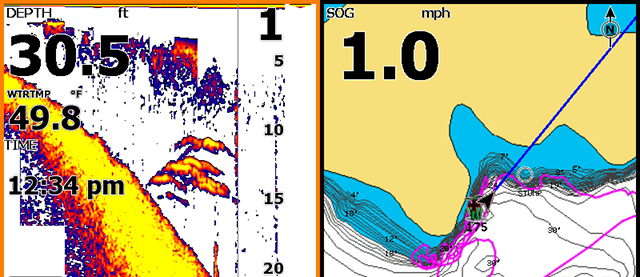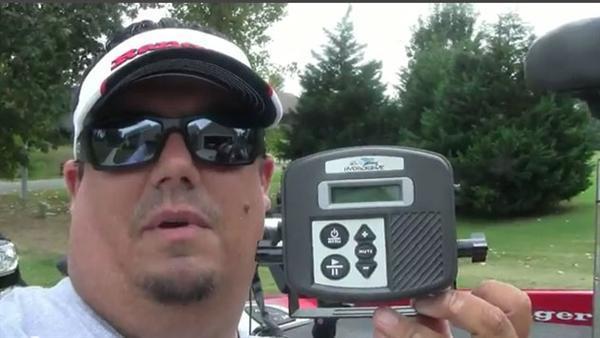We’re making an effort to help folks get their money’s worth on their fish finders. Knowing how to use sonar or side imaging can make you not only a more efficient angler but a more diverse angler. When you know how to use a fish finder to find not just hard bottoms but also forage and ultimately schools of fish you can spend your time honing your presentation and technique and less time searching aimlessly for bass, not know which lures and presentations will trigger a strike on that day.
Most anglers who fish from a boat have some sort of sonar, so we’ll start there. On a typical sonar, the thicker the return on the bottom, the more dense the bottom is. Take a Lowrance HDS 10 for example. When you see a hard bottom like gravel, chunk rock or shell beds, that bottom will be thick and yellow. Whereas when you pass over a softer muddier bottom, the bottom will seem more translucent or darker red or blue.
If you’re not seeing the contrasts like you think you should, you probably just need to adjust your sensitivity up or down. On my unit, I run my sensitivity up in the 70s, but I turn my noise rejection to low and my surface clarity to medium. For most of my use with sonar, I don’t really ever try to see the fish in the top 1 or 2 feet of my water column. I’m looking for the right looking bottom with forage or fish nearby.
One of my favorite hard bottom characteristics to find is an flooded roadbed. Now often the road isn’t well defined after years of erosion and soil placement on the road. But with your sonar setup to detect those contrasts in bottom, you can still see the hard bottom structure even if it has been silted over from floods and such. Usually the roadbed will be associated with some sort of rise on your screen as well and some of the best ones I’ve found even have chunk rip rap along them.

In the fall and again in the prespawn and post spawn periods, roadbeds can be bass and bait magnets. So I always like to find one if I’m looking for bass in an area. But a roadbed isn’t the only hard bottom that can be good. Shell beds have gained popularity with offshore fishermen over the years, although I find it humorous how many folks think they found a shell bed just because their jig is dragging through some rough gravel or chunk rock. There is a distinguishable “grabbiness” to a bed of shells and you’ll often pull them up either clamped on your line or snagged on a crankbait treble hook.
Some believe the bass are there for the shells. They are there for the clean hard bottom that attracts baitfish more readily. When current is pushed over them, it makes a buffet table for the bass.
Finding a hard bottom might take time scanning. I often pass over hard bottoms while idling around in creeks and bays on a major reservoir. I will the expand my search outward looking for key spots on a hard bottom area. Maybe there is a small pile of rocks, or a creek channel swing or cover on one part of the hard bottom that will make it the key spot in the area. When I find one hard bottom area, I will split my screen on my Lowrance HDS Gen 2 and search with sonar, down and side scan screens. Often I can use the side scan to tell me at what angle the road winds and then use the sonar to see the sharpest edges along the road or other objects, like brush, culverts, foundations and more.
As you can see from these screen shots, hard bottoms will stand out on your fish finder once you know how to use sonar and side scan together. A few tweaks to sensitivity, noise rejection, and surface clutter can give you a good read of what’s below. The shallower you are the more you will turn your sensitivity down on side and down scan. The deeper you are looking on your fish finder, the more sensitivity you must have.
Notice on this screen shot, we passed over a subtle roadbed. To the side of it was a small stake bed. The baitfish were positioned between the stake bed and the road. The fish however if you look closely were in the stake bed. We cranked a square bill over the top of the stakes and road a few times and as luck would have it, we caught a crappie. The more you make mental notes, then stop and fish what you see the more you will learn about how to use sonar and side scanning technologies and put together better fish catches.
















